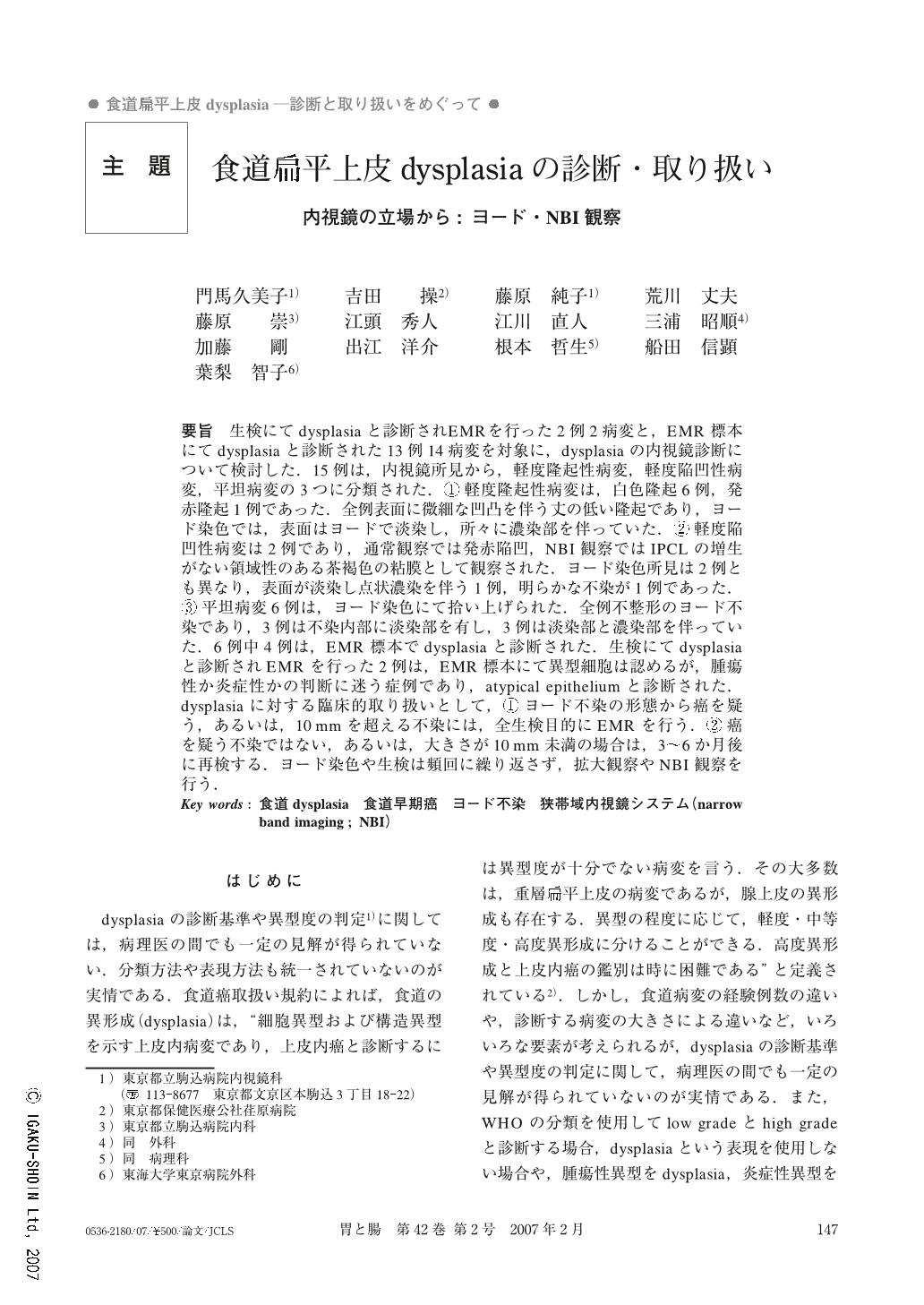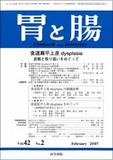Japanese
English
- 有料閲覧
- Abstract 文献概要
- 1ページ目 Look Inside
- 参考文献 Reference
- サイト内被引用 Cited by
要旨 生検にてdysplasiaと診断されEMRを行った2例2病変と,EMR標本にてdysplasiaと診断された13例14病変を対象に,dysplasiaの内視鏡診断について検討した.15例は,内視鏡所見から,軽度隆起性病変,軽度陥凹性病変,平坦病変の3つに分類された.①軽度隆起性病変は,白色隆起6例,発赤隆起1例であった.全例表面に微細な凹凸を伴う丈の低い隆起であり,ヨード染色では,表面はヨードで淡染し,所々に濃染部を伴っていた.②軽度陥凹性病変は2例であり,通常観察では発赤陥凹,NBI観察ではIPCLの増生がない領域性のある茶褐色の粘膜として観察された.ヨード染色所見は2例とも異なり,表面が淡染し点状濃染を伴う1例,明らかな不染が1例であった.③平坦病変6例は,ヨード染色にて拾い上げられた.全例不整形のヨード不染であり,3例は不染内部に淡染部を有し,3例は淡染部と濃染部を伴っていた.6例中4例は,EMR標本でdysplasiaと診断された.生検にてdysplasiaと診断されEMRを行った2例は,EMR標本にて異型細胞は認めるが,腫瘍性か炎症性かの判断に迷う症例であり,atypical epitheliumと診断された.dysplasiaに対する臨床的取り扱いとして,①ヨード不染の形態から癌を疑う,あるいは,10mmを超える不染には,全生検目的にEMRを行う.②癌を疑う不染ではない,あるいは,大きさが10mm未満の場合は,3~6か月後に再検する.ヨード染色や生検は頻回に繰り返さず,拡大観察やNBI観察を行う.
Fifteen patients with sixteen esophageal squamous cell dysplasias were included in this study. All patients underwent endoscopic mucosal resection (EMR). Pathological studies on resected specimens revealed neoplastic changes confined to the epithelium with well defined margins. Their grades of cell atypia and structural atypia were less marked in comparison with squamous cell carcinoma. Endoscopic findings allowed us to classify them into three groups : 1) mucosal changes with slight elevation (type 0-IIa-like lesion), 2) flat lesions without any elevation or depression (type 0-IIb-like lesion) and 3) mucosal changes with slight depression (type 0-IIc-like lesion). 1) Type 0-IIa-like lesions included whitish lesions (6) and reddish lesions (1). They showed minimum elevation associated with fine granular changes. They were stained very weakly by iodine staining. Dark brown spots were also noted in some lesion. 2) All type 0-IIb-like lesions (6 lesions) were regarde as iodine-negative lesions. They had irregular shapes and showed very weak staining with iodine. At the same time, dark brown spots were also noted in three cases. In two cases, histological findings were insufficient for differentiation of the cell atypias as neoplastic changes on inflammatory changes. 3) Type 0-IIc-like lesions (two cases) were noted as slightly depressed mucosal changes with slight reddening. Magnifying observation with narrow band imaging (NBI) revealed that type 0-IIc-like dysplasia lesions could be recognized as a mucosal change with slightly brown color. At the same time, low density of intrapapillary capillary loops were also noted. It is recommended as clinical managements of esophageal dysplasia that a dysplasia strongly suggestive of mucosal cancer especially if over 10 mm in size should be treated by EMR followed by histological studies on the resected specimen. Repeated endoscopic surveillance with intervals from three to six months is recommended when endoscopic findings are not strongly suggestive of cancer. Endoscopic observations assisted by magnifying endoscopy and NBI will be helpful for precise evaluation.

Copyright © 2007, Igaku-Shoin Ltd. All rights reserved.


